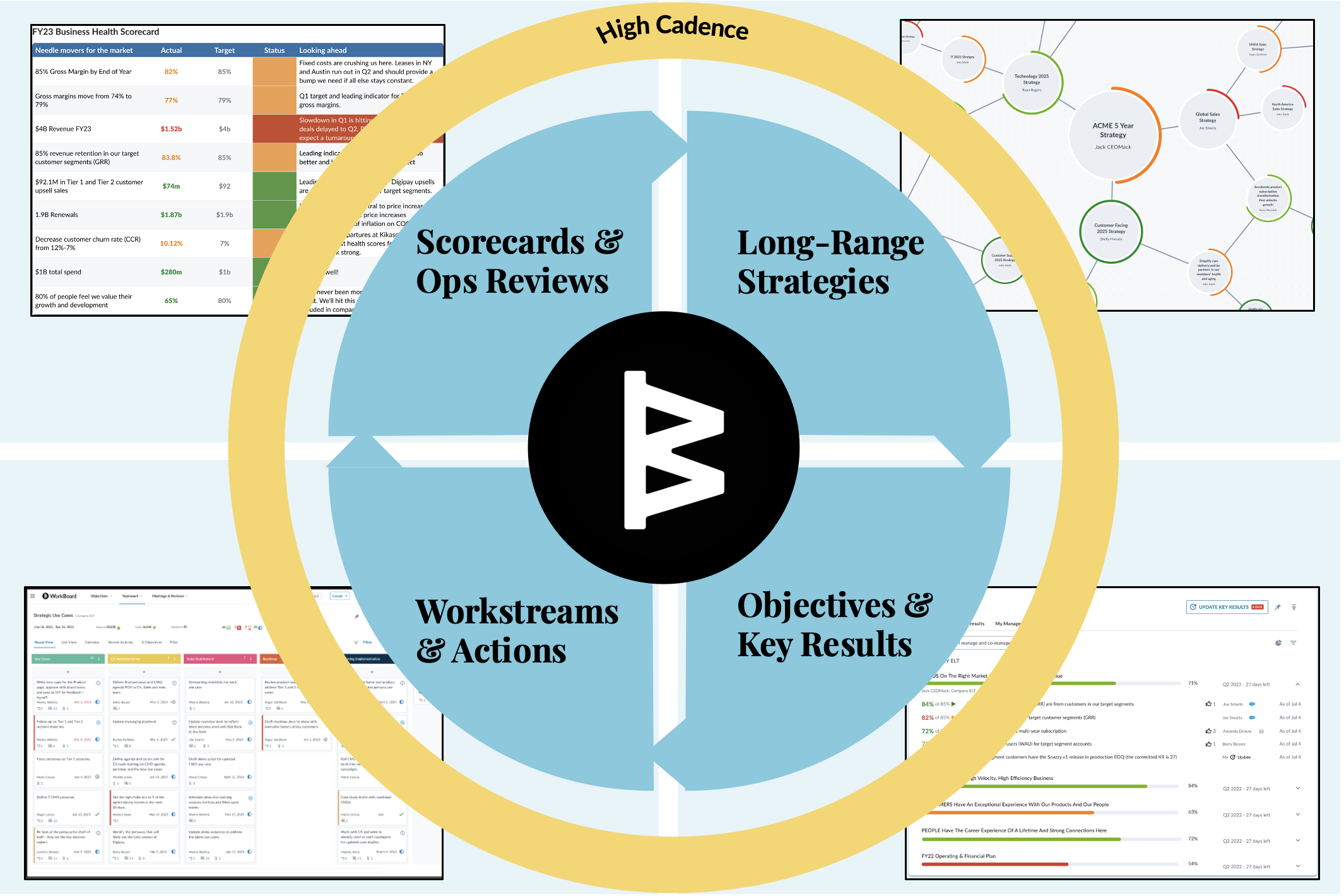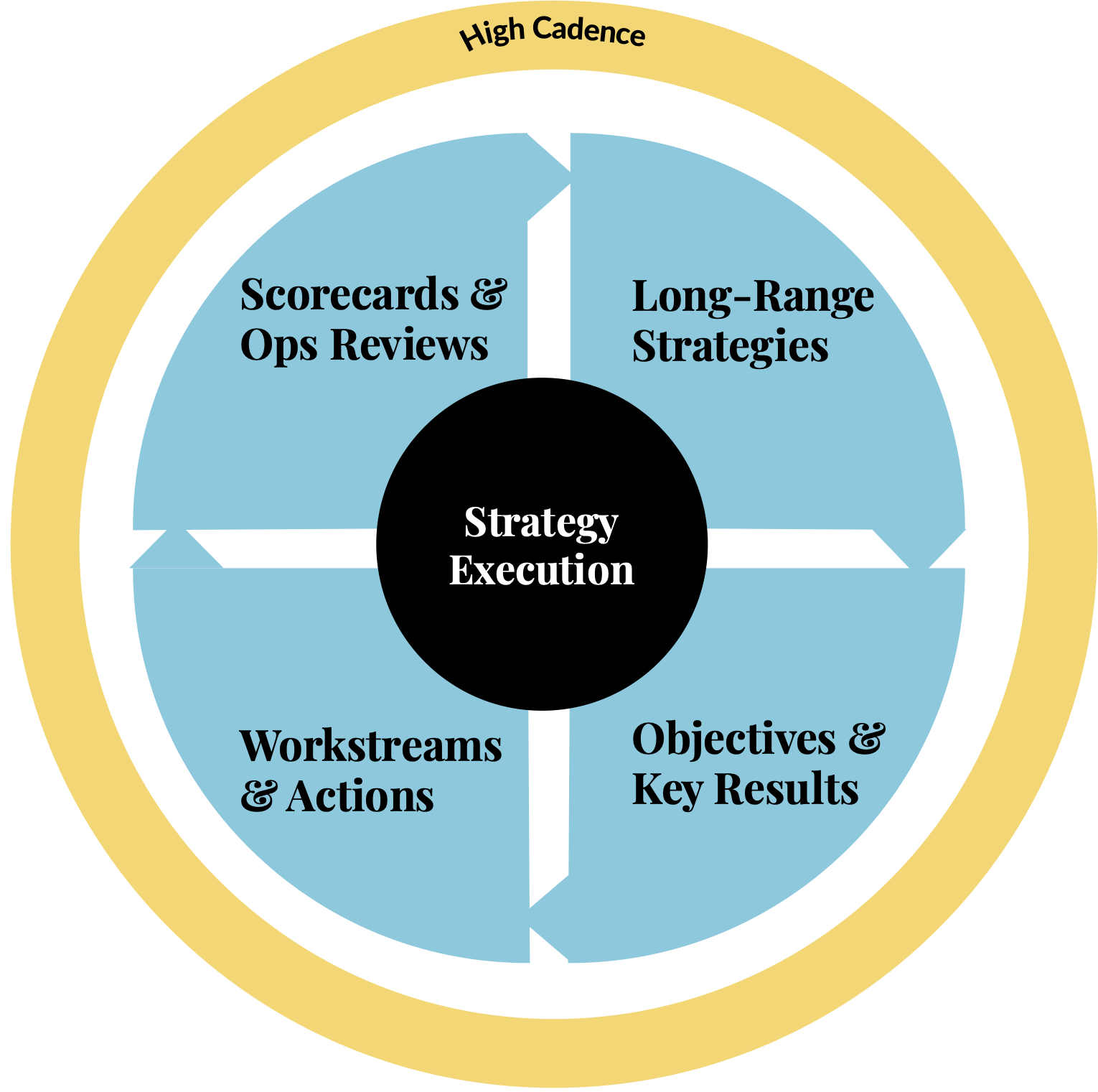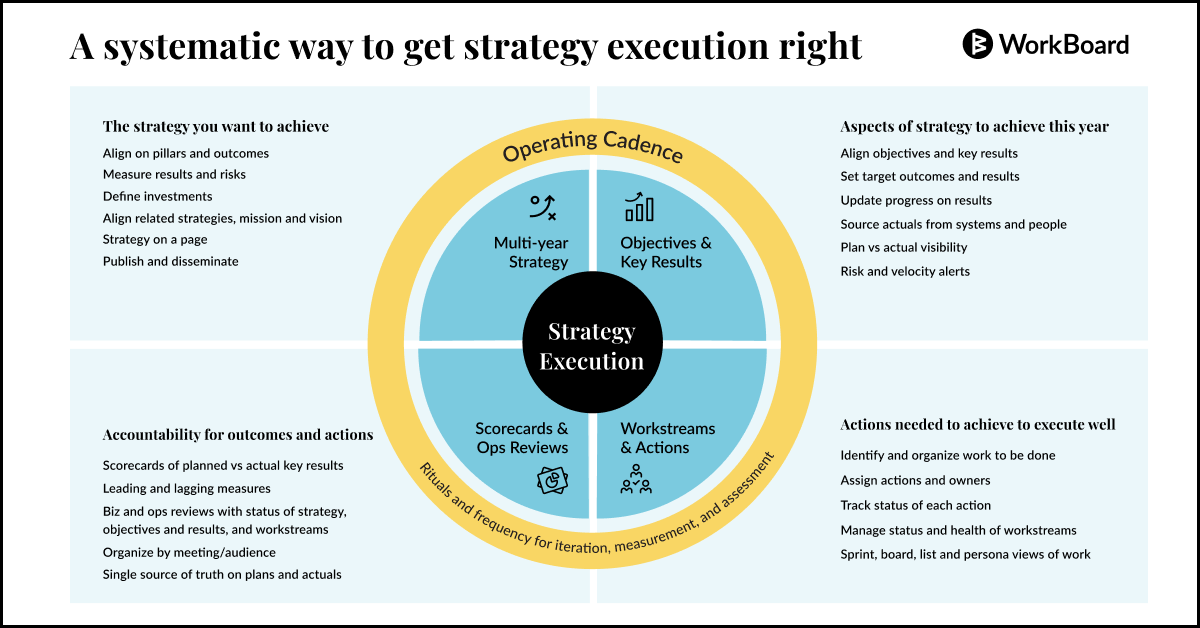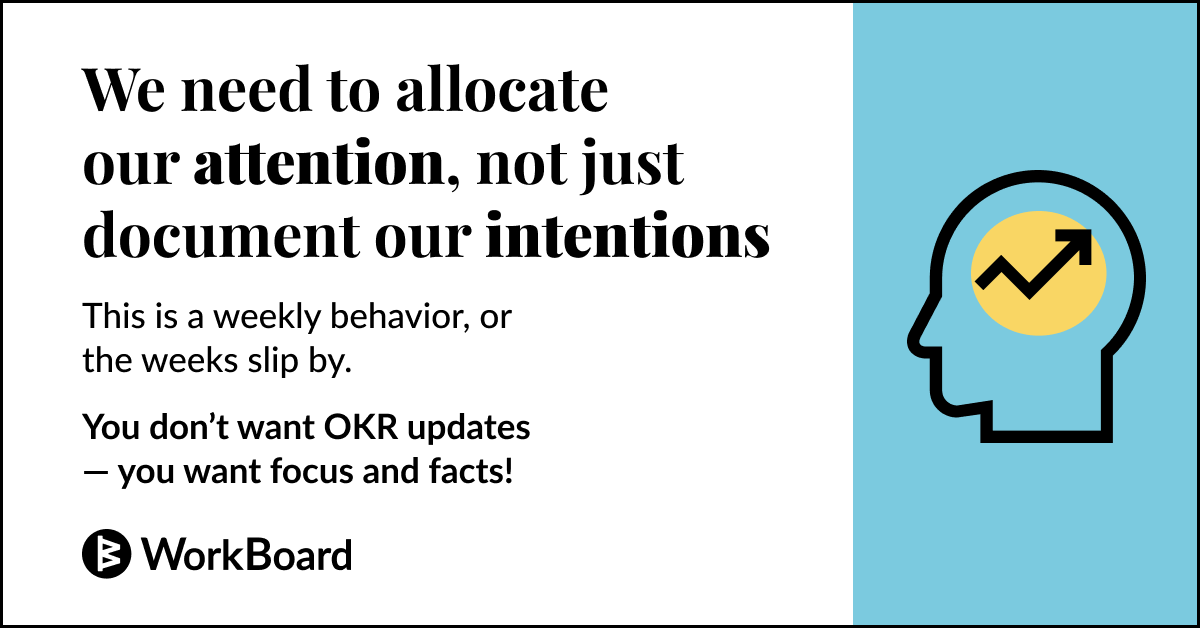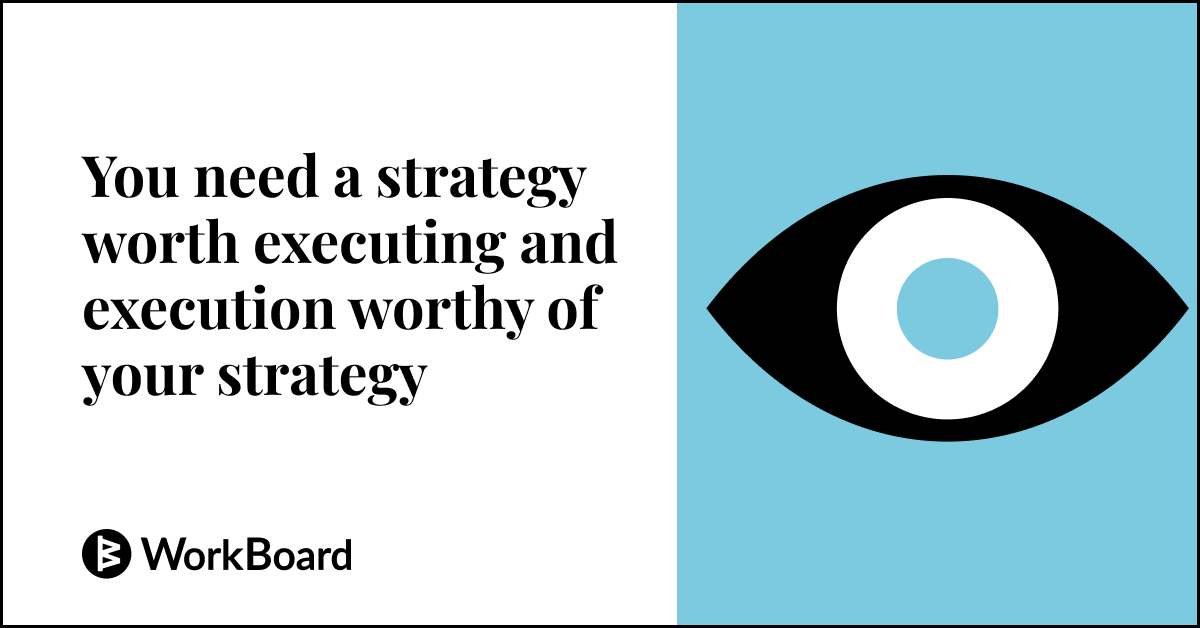We work with executives in 25 of Global 100 companies and almost half of the Fortune 500, and leaders that consistently achieve their strategies have 6 habits that stand out among peers. They are intentional about strategy execution and invested in ensuring their method, data set, and discipline is on par with the strategy itself. Their mantra is “we have a great strategy, now we need great execution.”
“WorkBoard makes it easy to take strategy and put it into execution.”
— Chief Information & Transformation Officer, Albemarle and 4DX aficionado
The 6 strategy execution habits that set these leaders apart:
- Set long range strategy that provides clarity and communicate outcomes that are more than financial - where and how they will win. They paint a vivid picture of the future and what winning looks like.
- Activate the strategy using a mechanism like OKRs to focus attention on the results needed now to propel the entity to future win. Translating strategy into specific, measurable objectives and key results connects today's efforts to tomorrow's outcomes.
- Use quarterly key results that are headlights (lead measures) rather than taillights on end of period results (lag measures) to increase certainty and speed. Leading indicators that drive decisions week to week help you control your performance where lagging indicators simply tell you where you've been.
- Have a weekly de-risking ritual. The most common is designed around a WorkBoard scorecard with those headlight key results and actions for every item in the red so no risk goes unnoticed for more than 7 days. They expect an update on the remediation actions each week.
- Drive high cross-functional attention and coordination using WorkBoard scorecards for objectives and key results and discuss progress to plan with all stakeholders at least twice a month. Alignment and accountability across silos are critical for many strategies, and this ritual makes that coordination habitual.
- Use Fridays to understand how execution is really progressing deep in the organization using data in the WorkBoard strategy execution platform - what's working, what's not, and what needs to be discussed next week in staff and 1on1s. They operate with high understanding of the truth on the ground rather than “packaged truth” that has passed through and been reframed by many hands before it reaches them.
In summary, effective leaders translate strategy into specific objectives, focus on leading indicators of performance, foster cross-functional alignment, and stay connected to what's really happening. They have a disciplined system for execution, not just strategy.
These executives have the strategy execution trifecta of method, data, and discipline.
Common methods and frameworks
- Vital Few (Pareto)
- Big Rocks (Rockefeller Method)
- 4DX (Four Disciplines of Execution)
- Play to Win (Five Step Strategy Model by A.G. Lafley and Roger Martin)
- V2MOM (Salesforce’s own method)
- Hoshin Kanri
- OKRs (Andy Groves at Intel captured in Measure What Matters by John Doerr)
Without a real mechanism for aligning on the strategic outcomes, measuring results against success targets, and driving accountability for those results, odds are you aren’t aligned and or driving peak performance. To execute on strategy with high predictably and profitably, you need one – and only one – strategy execution method. If your organization uses two or more of these frameworks, the signals conflict and compete; many methods is the equivalent of none.
Common methods and frameworks
- Vital Few (Pareto)
- Big Rocks (Rockefeller Method)
- 4DX (Four Disciplines of Execution)
- Play to Win (Five Step Strategy Model by A.G. Lafley and Roger Martin)
- V2MOM (Salesforce’s own method)
- Hoshin Kanri
- OKRs (Andy Groves at Intel captured in Measure What Matters by John Doerr)
Consistency, decision data, and disciplined follow through matter more than which method you choose. At their core, all seek to do same thing: Define strategic outcomes, allocate resources to them, drive focus on them, and ensure accountability for them.
WorkBoard customers use a variety of methods in the platform today, and the platform is essential to the data and discipline required for great execution.
“We are so much better aligned! Monthly business reviews went from 4 hours to 45 minutes, they’re risk-focused, and no one wastes time gathering and presenting stale data.”
— Tina Murphy, President & CEO at GHX
Consistency and alignment are difficult when slides are the medium, decisions suffer from the lack of data transparency, and there is no real means of detecting risks to remediate them week to week because of the tremendous burden manually gathering facts places on any organization.
OKRs - first among equals
Over the past 5 years, many enterprises adopted the OKR methodology, very often spurred by reading Measure What Matters by John Doerr. He describes how Andy Grove used the methodology at Intel in its peak growth period and the impact it had on the company and on John as a young, motivated engineer.
“We reestablished OKRs to drive accountability and transparency across the organization... spark plugs to our execution engine.”
— Pat Gelsinger, Intel CEO on Jan 27 earnings call
Today, Intel uses WorkBoard for OKRs and strategy execution, and new CEO Pat Gelsinger describes them in his earnings calls as the “spark plugs in their execution engine.” OKRs have become the most popular method for executing strategy for several reasons:
- OKRs are an iterative approach with a faster pace that is better suited to the rapid rate of change in the external environment. This enables organizations to adapt their strategies and execution more quickly.
- The OKR framework is relatively simple, with objectives articulating the intent and key results defining how success will be measured.
- The key results in OKRs are the best possible, not most probable, results so teams actively discuss what great looks like and make smarter tradeoffs of less important efforts competing with their best outcomes. This eliminates the root cause of a lot of mediocrity: Aiming low, promising low, and delivering low impact.
- OKRs are a team sport, not driven by individual MBOs, which can create unhealthy internal competition and misalignment within teams. Team authorship creates team ownership in ways that manager-dictated targets do not).
- Key results are intended to help teams make better decisions and choices week-to-week, not just report results to management after the fact. This drives real-time execution speed.
- Transparency is baked into OKRs, which are typically made visible across the organization. This enhances accountability and makes cross-functional collaboration both possible and practical.
“We use WorkBoard OKRs, Biz Reviews, Workstreams, Meetings, the Canvas, Heatmap — all of it — to advance our transformation agenda faster.”
— Chris Rome, Head of Delivery Operations, Virgin Media O2
Well thought out strategy deserves well thought out execution
To improve your organizations achievement of strategic outcomes, increase the discipline and data you use to drive strategy execution. Choose a methodology, use a platform that functions as a single source of truth and transparency for everyone, and have the facts and fortitude to focus on what matters every week.





